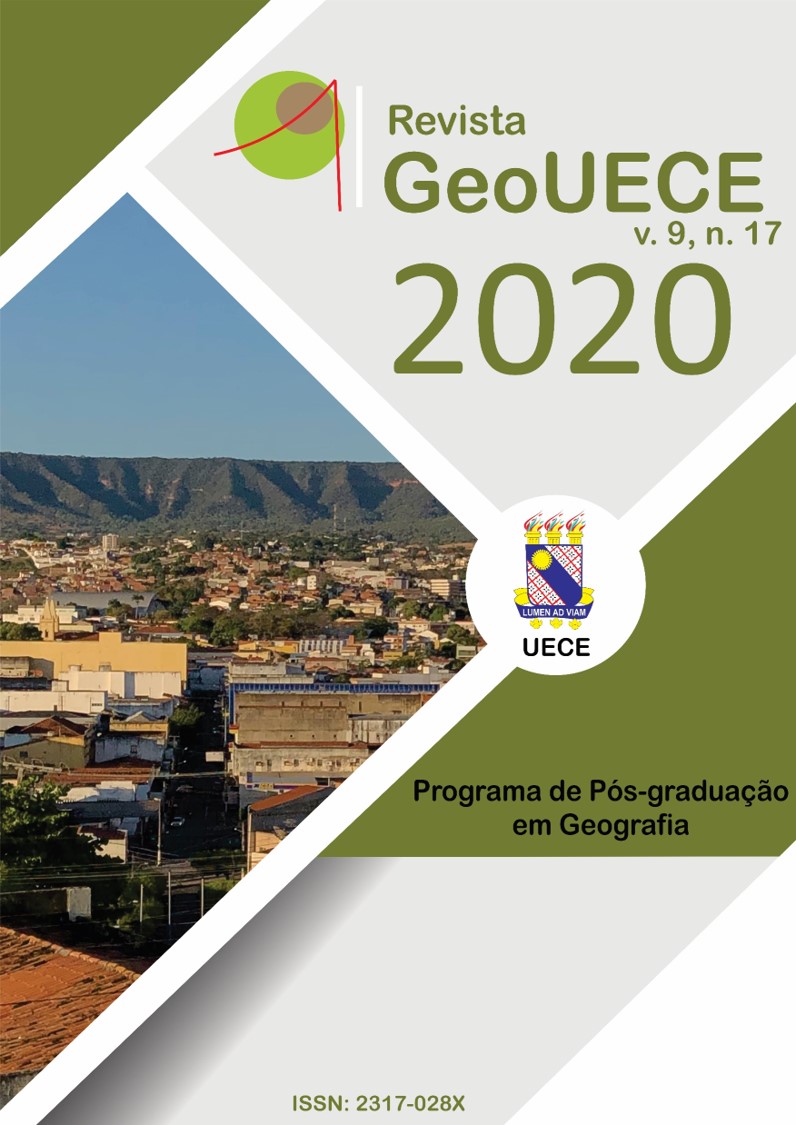ANÁLISE DOS CONSTRASTES TÉRMICOS EM EPISÓDIOS DE INVERNO E VERÃO EM JUAZEIRO DO NORTE, CEARÁ
Keywords:
Contraste térmico, Temperatura do ar, Temperatura de superfícieAbstract
This work has the purpose of developing a mapping of the thermal differences of air temperature and surface temperature in the municipality of Juazeiro do Norte in a winter and spring episode of 2018. The main sources of data are temperature measurements of the nocturnal mobile air and orbital images to estimate the surface temperature. The two fields carried out through the mobile transect methodology contemplated the routes in the north-east and west-east directions starting at 21:00 hours and totaling 50 minutes, collecting the total air temperature of 57 points distributed in the urban perimeter , measured from an external sensor digital thermometer with 2m Icotem cable and a GPS (Global Positioning System) Garmin Map 76CSX receiver to mark the coordinates of the respective registers. The surface temperature was estimated using orbital images from the Landsat 8 satellite, TIRS thermal sensor, from the transformation of digital numbers into radiance and then into temperature (ºC) translated into syntaxes that are included in the raster calculator tool in ArcGis software. The results show that the thermal variations showed differences of up to 5 ° C in the municipality, demonstrating the amortization that green and drainage areas can exert in this environment, contrary to highly urbanized environments. Another result concerns the difference between air and surface temperatures, where surface temperatures exceeded 40 ° C in densely constructed environments, while the air temperature measured through the transect did not exceed 31 ° C.
Downloads
Metrics
References
ALCOFORADO, M. J.; ANDRADE, H.; LOPES, A.; OLIVEIRA, S. A ilha de calor de Lisboa. Aquisição de dados e primeiros resultados estatísticos para aplicação ao ordenamento urbano. Geophilia – o sentir e os sentidos da Geografia, Lisboa, C.G., 2007, pp. 593-162.
AMORIM, M.C.C.T. DUBREUIL,V. CARDOSO, R.S., MODELAGEM ESPACIAL DA ILHA DE CALOR URBANA EM PRESIDENTE PRUDENTE (SP) – BRASIL. Revista brasileira de climatologia. Associação Brasileira de Climatologia – ABClima, 2015.
ARNFIELD A.J. Two decades of urban climate research: a review of turbulence, exchanges of energy and water and the urban heat island. International Journal of Climatology; 23, p. 1-26, 2003.
FERREIRA, A. G. F.; MELLO, N. G. da S. Principais sistemas atmosféricos atuantes sobre a Região Nordeste do Brasil e a influência dos oceanos Pacífico e Atlântico no clima da região. Revista Brasileira de Climatologia, v.1, nº 1, 2005.
FUNCEME. Zoneamento geoambiental do estado do Ceará: Parte II: Mesorregião do sul cearense. Fortaleza, 2006.
GALVANI E., LUCHIARI A. Critérios para classificação de anos com regime pluviométrico normal, seco e úmido. In: VI Simpósio Brasileiro de Climatologia Geográfica, 2004, Aracaju. Anais, 2004. p 20-29.
GARTLAND, L. Ilhas de calor: Como mitigar zonas de calor em áreas urbanas. São Paulo: Oficina de textos, 2010. 248 p.
LOPES, A. O sobreaquecimento das cidades. Causas e medidas para a mitigação da ilha de calor de Lisboa. In: Territorium, 15: 39‐52. 2009.
NIMER, E. Climatologia do Brasil. Rio de Janeiro: IBGE, 1979. 422 p.
RAMPAZZO, C. R., SANT’ANNA NETO, J. L. Clima e qualidade ambiental urbana em alfredo marcondes/sp:análise em episódio de inverno. In: Revista Geonorte, Edição Especial 2, v.2, n.5, p. 194– 206, 2012.
ZANELLA, M. E. Caracterização climática e os recursos hídricos do estado do Ceará. In: SILVA, J. B. da.; DANTAS. E. W.; CAVALCANTE. T. (Org.). Geografia do Ceará: Um novo olhar geográfico. 2. ed. Fortaleza: Edições Demócrito Rocha, 2007. P. 169-188.
ZAVATTINI, J. A. & BOIN, M. N. Climatologia Geográfica: Teoria e Prática de Pesquisa. Campinas: Alínea, 2013. 150 p.

































